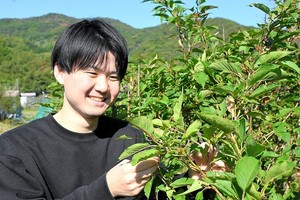THE ASAHI SHIMBUN
March 7, 2022 at 18:52 JST
FUKUSHIMA--A sign along the Manogawa river that runs through Minami-Soma, Fukushima Prefecture, is faded, but the message is clear--and perhaps unnecessary.
“Regulations have yet to be lifted,” it says. “Please do not conduct fishing activities.”
The sign is located on a riverbank about 30 kilometers north of the stricken Fukushima No. 1 nuclear power plant run by Tokyo Electric Power Co.
The area used to be crowded with people trying to catch “ayu” (sweetfish). But anglers from near and far stopped visiting the area long ago, and now, hardly anyone is around to see the sign.
After the 2011 nuclear disaster, a local association of fisheries cooperative set up the “no fishing” signs at about 50 locations along the river.
Calls to suspend shipments of river fish and to refrain from fishing have continued since the nuclear disaster started 11 years ago, even for rivers outside the Tohoku region.
In the Manogawa river, ayu, “ugui” (Japanese dace) and “yamame” (masu trout) were found with concentrations of radioactive substances that exceeded the national safety standard.
“There are people who say, ‘I don’t think I can go fishing again in my lifetime,” said Yukiharu Mori, 60, who owns a fishing goods store in Minami-Soma.
His shop’s sales have plummeted, and many other fishing goods shops in the city’s area have gone out of business, he said.
RESTRICTIONS LIFTED FOR SEAFOOD
The nuclear disaster led to restrictions on shipments of seafood products in five prefectures, stretching from Aomori to Ibaraki.
These restrictions have been lifted in stages because radioactive substances more easily diffuse in the sea, and fish species have been confirmed safe to eat.
Currently, the shipment restrictions apply only to “kurosoi” (black rockfish) caught off Fukushima Prefecture.
But all restrictions remain for catches from 25 rivers and lakes in five prefectures--Fukushima, Miyagi, Ibaraki, Gunma and Chiba.
In some areas along the Agatsumagawa river in western Gunma Prefecture, shipments of “iwana” (char) and yamame are still restricted.
According to Gunma prefectural officials, radiation doses were relatively high in certain areas around the Agatsumagawa river immediately after the nuclear disaster due to the wind direction and geographical features. That has led in part to the prolonged restrictions.
In a 2020 prefectural survey, the radioactivity concentration level in iwana was 140 becquerels per kilogram. In a 2019 survey, the level for yamame was 120 becquerels per kilogram.
The national standard for both fish is 100 becquerels per kilogram.
“Even when the figure goes down and we think it is safe, we find fish with high figures every few years,” a Gunma prefectural official said. “That makes it difficult for us to take a step toward lifting the restrictions.”
Toshihiro Wada, an associate professor of fish biology at Fukushima University, said river fish “have continued to consume radioactive materials from food” provided through forests that have yet to be decontaminated.
The central government has conducted decontamination work mainly in residential areas of Fukushima Prefecture and surrounding prefectures.
But such work has not been done in most parts of large forested areas. Insects and other critters ingest still-contaminated tree leaves or algae at river bottoms. The river fish then consume the creatures, which has kept radioactive concentrations high in the fish.
A team of researchers from Fukushima University, the Fukushima prefectural government and the National Institute for Environmental Studies has surveyed areas along the Otagawa river that stretches from Namie to Minami-Soma in Fukushima Prefecture since 2018.
The study includes checking radioactivity levels in the river fish and insects.
The upper part of the Otagawa river is located in a “difficult-to-return” zone because of still-high radiation levels.
In an on-site survey in December, the researchers found the radiation dose rate in the air of an upstream forested area within the difficult-to-return zone was 2 to 3 microsieverts per hour. That level was 20 to 30 times higher than the dose rate in the city of Fukushima.
The researchers also found up to 9,000 becquerels of radioactive materials per kilogram in yamame caught in the upper portion of the river in 2018, and up to 12,000 becquerels per kilogram in iwana.
The radioactivity concentrations in tree leaves and river algae were several thousand to tens of thousands of becquerels. Crickets, bees and other land and aquatic creatures found in the yamame’s stomachs are believed to have eaten the contaminated leaves and algae.
Insects in the area contained radioactivity levels of several hundred to several thousand becquerels, the researchers said.
Yumiko Ishii, a team member and a chief researcher at the NIES, said that larger yamame had radioactivity concentration levels that were higher than those in the food that the fish ate.
“Unless you do something about the radioactive materials in forests, the radioactivity concentration levels in fish will not go down,” she said. “But decontaminating forests is not realistic, either.”
(This article was written by Keitaro Fukuchi and Nobuyuki Takiguchi.)




















A peek through the music industry’s curtain at the producers who harnessed social media to help their idols go global.
A series based on diplomatic documents declassified by Japan’s Foreign Ministry
Here is a collection of first-hand accounts by “hibakusha” atomic bomb survivors.
Cooking experts, chefs and others involved in the field of food introduce their special recipes intertwined with their paths in life.
A series about Japanese-Americans and their memories of World War II